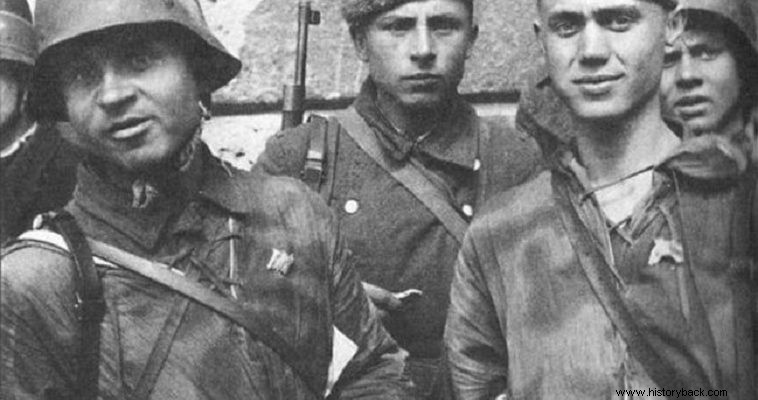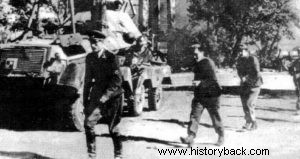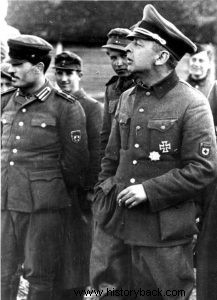
On October 6, 1941, German invaders occupied Bryansk in the USSR. A little later a technician at a local factory and a teacher at a local technical school, Bronisław Kaminski and Konstantin Voskoboynik presented themselves to the Germans and offered their services.
The Germans accepted and soon a force of 200 was formed which was used to "pacify" the civilians and pursue the partisans. By the beginning of 1942 the strength of the department had more than doubled, and after Voskoboynik's death, only Kaminsky assumed command.
By the spring of 1942 the division numbered 1,400 men and Kaminsky and his men were placed under the command of the 2 Panzer army with the mission of protecting the rear from the partisans . Mr. Kaminski was named major. In June 1942 Kaminsky and his men took part in the anti-partisan Operation Vogelsang alongside German army forces and Hungarian forces.
After that, in the fall of 1942 Kaminsky's force was named the Russian National Liberation Army and began recruiting men, Soviet nationals and from the German POW camps. The unit was equipped with a Soviet 76mm cannon. and two BT-7 light tanks.
The unit received German uniforms and by January 1943 it numbered nearly 12,000 men, 11 tanks and armored vehicles and an anti-aircraft artillery squadron. The unit took part in anti-guerrilla operations using barbaric methods.
After the German defeat in Kursk, mass desertions began, while attempts were also made against Kaminski. Due to the German retreat Kaminski, his men and their families were also evacuated. About 30,000 people involved in the unit were transferred to the Vitebsk region of Lekorussia.
By then the unit was held responsible for 10,000 civilian deaths in the Bryansk region . However, desertions continued. Kaminsky strangled with his own hands one of his officers who wanted to go over to the Soviet side with his men . By October 1943 the unit had lost 2/3 of its strength.
In early January, however, Himmler decorated Kaminski and assigned him to reorganize his unit. The reorganization took place in Belarus and the unit was joined by similar formations of Soviets who had opposed the USSR.
Named the "Kaminski People's Brigade", the unit joined the "Götberg Force", under the SS general of the same name, together with the Dirlewanger brigade. It was the first time that Kaminsky came under the control of the SS and in the operations that followed over 20,000 civilians were killed.
Following these "successes" the unit officially joined the Waffen SS as the Assault Brigade of the Russian Liberation Army (RONA) with Kaminsky promoted to SS brigadier general. Meanwhile the unit was renamed 1 h Russian Division of the Waffen SS and was sent to Warsaw to put down the Polish uprising.
There the unit "acted" in such a way that it earned the loathing of even the SS. In one case instead of attacking the Poles the men found themselves looting abandoned houses . When the attack was finally carried out it was easily repulsed by the Poles. What they could not do against the armed Poles, the men of the unit did against civilians, slaughtering, burning, raping, murdering thousands.
Even the Germans understood that Kaminsky's men were common bastards with no purpose and no ideology other than stealing and saving their flesh. On one occasion a battalion and artillery of Kaminski were attacked at night by a detachment of 80 Polish insurgents. Most of Kaminsky's men were drunk and died easily…
Those who survived put it to their feet by abandoning their weapons. Kamisnki was also killed at the same time. The circumstances of his death remain mysterious. Officially the Germans announced that he was killed in a Polish ambush. But it is rumored that they killed him themselves as he was no longer useful.
The unit continued to exist after the death of its leader later joining the forces of the traitorous Soviet General Vlasov following their fate. After the war, men of the unit who were captured by the Americans and the British were handed over to the Soviets and executed.
Others tried to hide but many were discovered in the USSR well into the 1960s and also executed. In 1978 a female member of the unit, Antonina Makarova, was discovered and executed for being responsible for over 1,000 murders.

Kaminski's men in Warsaw.

Kaminsky (right).
